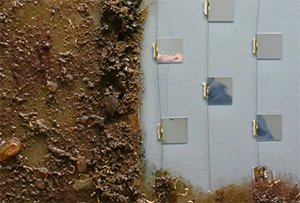With environmental and regulatory pressure to find non-toxic alternatives to biocide-laden antifouling coatings, a variety of innovative technologies are emerging:
• At the University of Sydney Nano Institute, researchers have developed a non-toxic nanostructured surface coating with antifouling properties. The coating uses “nanowrinkles” inspired by the Nepenthes carnivorous pitcher plant. The nanoscale materials were tested by tying them to shark netting in Sydney’s Watson Bay, showing their efficiency at resisting biofouling in a marine environment.
“We are keen to understand how these surfaces work and also push the boundaries of their application, especially for energy efficiency,” said Associate Professor Chiara Neto, research team leader. Increased drag on ship hulls due to biofouling is estimated to cost the Australian shipping industry $320 million per year, according to the university.
• European Union-funded eSHaRk is developing a self-adhesive and non-toxic fouling release foil for commercial seagoing vessels. It is produced by applying the release coating onto a self-adhesive plastic film with an embossed surface to reduce friction, according to the project consortium.
“This innovative new technology not only maintains current fouling protection standards but is superior to existing solutions in terms of eco-friendliness, ease of application, durability and drag reduction, all of which will lead to fuel savings and a reduction in greenhouse gas (GHG) emissions,” eSHaRk states on its website.
The system is based on PPG’s 100 percent silicone binder technology and a self-adhesive film designed by Mactac for underwater use. For large commercial vessels, the consortium is developing robotized application technology. • AkzoNobel is partnering with Royal Philips to prevent hull fouling by using ultraviolet light-emitting diodes (UV-LED) in a protective coating.
The biocide-free technology is based on ultraviolet light’s effect on biological organisms, which are deterred from attaching because the UV light is an irritant. The LEDs have a minimum lifetime of 35,000 hours, meaning any vessel can be protected throughout a full docking cycle, according to AkzoNobel. The UV light is not visible to the human eye, so ships will not “glow in the dark.”
The product will be developed for ships, yachts and offshore assets and is expected to be on the market in 2023.

